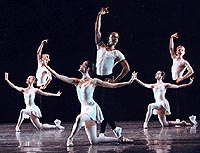
This year, the School of American Ballet’s annual showcase of its students infused new life into two staples of the academy’s parent company, the New York City Ballet – Balanchine’s Tombeau de Couperin and Robbins’s Fanfare. Tombeau, created in 1975 to the Ravel score, is an exquisite ensemble piece for eight couples – no stars, no soloists, every dancer equal. Its magically shifting patterns reflect both the court dancing of Couperin’s time and the related configurations and communal interplay of American square dancing. Richard Tanner, assisted by Susan Pilarre, captured the delicately filigreed style of the piece that the music dictates. Their protégés moved through the lovely configurations of the dance with luminous pleasure, apparently realizing themselves to be links in the chain of beauty (in the words of the great Danish ballet master August Bournonville), no less wonderful or important for being anonymous.
As danced by preprofessionals rather than their often more condescending elders, the 1953 Fanfare, staged by Christine Redpath, assisted by Pilarre, overcame the onus of being a ballet one is embarrassed to watch without the excuse of accompanying a child. The choreography fulfills the instructive chore of the music – both the stuff of Family Matinées – which is to deconstruct the orchestra to its component instruments, then reunite them via a fugue. The SAB performers entered into the occasion joyously, relishing their mini-solo or small-group bits, the frequent wit of Robbins’s invention, and the empathy involved in the instruments’ uniting to create something larger than themselves. Carla Körbes, a petite, juicy dancer, was as dulcet a Harp – the role is a tiny star turn – as anyone could wish.
Christopher Wheeldon, NYCB’s fair-haired boy, contributed the latest entry in a choreographic career that is being ardently supported by dance observers desperate for emergent choreographic genius. (I’m desperate right along with them, but I find Wheeldon’s work to date dully conventional and intolerably sentimental.) The new piece, Scènes de Ballet, set to the Stravinsky score of that name, is a showcase for 62 SAB pupils, ranging from tiny accomplished female sprites and grave little boys pushed beyond their powers through the adolescents whom Balanchine, in his day, wisely cloistered until they matured as professionals. The proceedings Wheeldon has devised are overbusy and, where not pointless, banal (little moppet gazing wistfully at the near adults’ love duet, etc.). The gimmick of the piece is a forced-perspective set, by Ian Falconer, of a studio looking out on the onion-dome towers of Mother Russia. An endless barre plunges downstage at an angle, bisecting the space so that the action can be mirror-imaged. The doubling cried out for crowd control. I thought the whole affair looked suspiciously like fodder for a publicity campaign. What’s worse, it took up space on the program (and, significantly, in the young dancers’ education) that, in more scrupulous times, would have been devoted to those master choreographers of the nineteenth century, the Russian Petipa and the Danish Bournonville.
The indispensable Suki Schorer, who mounted Balanchine’s 1967 Valse Fantaisie, captured the windswept, witchy romance that lies at the heart of this swift, ravishing miniature to Glinka. She made both her alternating casts of principals look breathtaking. Megan Pepin, who devours space with glee, and Amar Ramasar, the incarnation of a Persian prince (he’s from the Bronx), were fine in other roles on the program as well; Sarah Ricard and Andrew Veyette were transformed by Schorer’s coaching, which seems to be based on her grasping, both intuitively and analytically, the essence of any Balanchine ballet she tackles – its rhythms, its tone, its very spirit.